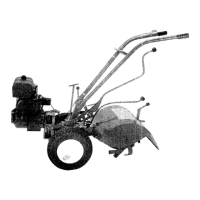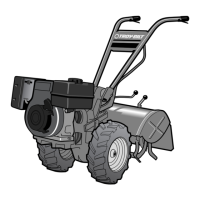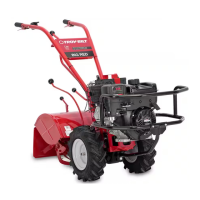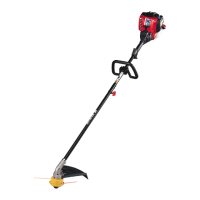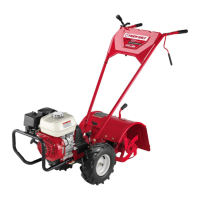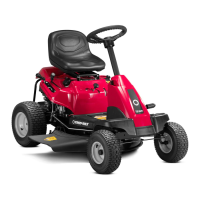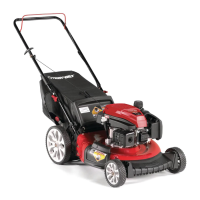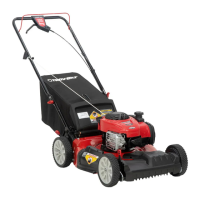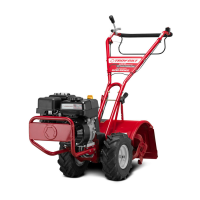62
ground. (See Photo 5/9.) They tend
to
clog up
badly in sod
or
any tall
or
lengthy vegetation
and are best used in clear
ground
only. They
will till 6
to
8 inches deep.
Pick tines are especially
good
where you have
hard clay and
ground
that
has
not
been tilled
for
several years. Although Bolo tines will
normally
till
any
ground
that
you run up a-
gainst,
they
occasionally
will require several
passes over the same very hard,
rocky
ground
to make
much
headway. Using Pick tines in
hard packed soil
will
often break up the soil
in just a few passes.
Naturally,
as
you
cultivate
your
garden and
put
back more
organic
material into the
soil-
growing
more vegetation
for
the
tiller
to
chop
up, you will reach a
point
where you have
im-
proved
your
soil
conditions
so much that the
early advantages
of
Pick tines will give way to
the
all-around
performance
of
Bolo tines.
CULTIVATING
TINES
These specialized tines (see Photo 5/10) are
best
for
cultivation, which should be
only
one
or
two
inches deep
to
avoid damage to the roots
of
plants. However, they will
till
as
deep
as
5
inches and
disturb
less soil than
will
Bolo
tines.
They are an ideal
choice
wherever you wish
to cultivate between rows near shallow-rooted
crops, and
for
berries, vineyards, orchards and
shrub
or
tree nurseries. In fact, many profes-
sional growers
prefer
these tines
for
cultivating.
MATCHING
WHEEL AND
TINE
SPEEDS
TO
PARTICULAR JOBS
With a little experimenting, you will soon be
able to find the
proper
depth, wheel and tine
speed that is
just
right
for
the piece
of
soil you
are
working
on. (See Photo 5/11). What this
means is:
1.
You advance the
throttle
lever on the handle-
bars to keep the engine
running
at
a power lev-
el that
is
adequate to
do
the job.
2.
You have the depth regulator set in a
notch
that
is
not
so deep that it causes the engine to
labor
or
causes the
tiller
to
jump.
3.
That you have the tines
turning
over
fast
enough
to
really
bust
up
the
soil
with
a
mini-
mum
number
of
passes.
When
your
Troy-Bilt
is
working
in
this
man-
ner, you can hear if the engine is
not
laboring
very hard and see
that
the
tines are moving
well and breaking
up
the
dirt
to
small friable
granules. At the
proper
match
of
wheel and tine
speeds, you will get the
job
done
just
as
quick-
ly, more effectively and will achieve results
that are better and more satisfying. See Photo
5/12.
TILLING VERTICALLY
ON
SLOPES
If you garden on a slope,
your
Troy-Bilt
Roto
Tiller Power-Composter can
be
the greatest
benefit to you if you are able to plant verti-
cal rows up and
down
the slope. You can till
up the slope in high gear. In soft soil
or
weeds,
you may have to
lift
the handlebars up
slight-
ly
as
you
go
uphill. Till
uphill
on
the
first
pass. It wi
II
do
a better
job
than
going
downhill.
Till
downhill
in
low
gear. Never
shift
wheel
speed gears
if
the
tiller
is
heading
up
or
down
a
slope. See Safety Rule No. B.7 on
page
38.
The
powered wheels
of
the
Troy-Bilt
will
pull
the
tiller
up the hill
to
do
your
digging
and
will
also
hold the
tiller
back while
you
go
downhill
to
prevent the
tiller
from
going
too
fast. See
Photo
5/13 and Photo 5/14.
Tilling vertically on a slope
will
permit
you
to
prepare the entire area
for
your
seedbed
as
well
as
provide enough room between rows so
that you can cultivate between the rows
during
the
growing
season.
Surprisingly
enough,
growing
a garden vertically
on
a
slope
does
not have to involve much
of
a
problem
with
soil erosion,
as
long
as
you
have
put
in enough
organic material to improve the
moisture
hold-
ing
ability
of
your
soil and
do
not
leave
foot-
prints
or
wheelmarks. Soil in this
condition
will
be broken
up
enough to prevent packing, and
will be held together well enough
by
those
or-
ganic materials so that it will absorb water.
Tilling
vertically
up
and
down
a slope allows
you to make
tilling
passes
while
walking
along-
side the tiller, with one hand
controlling
the
tiller, at the same time
thereby
eliminating
troublesome wheelmarks and
footprints
that
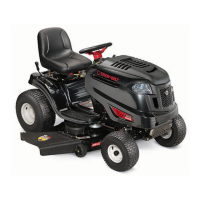
